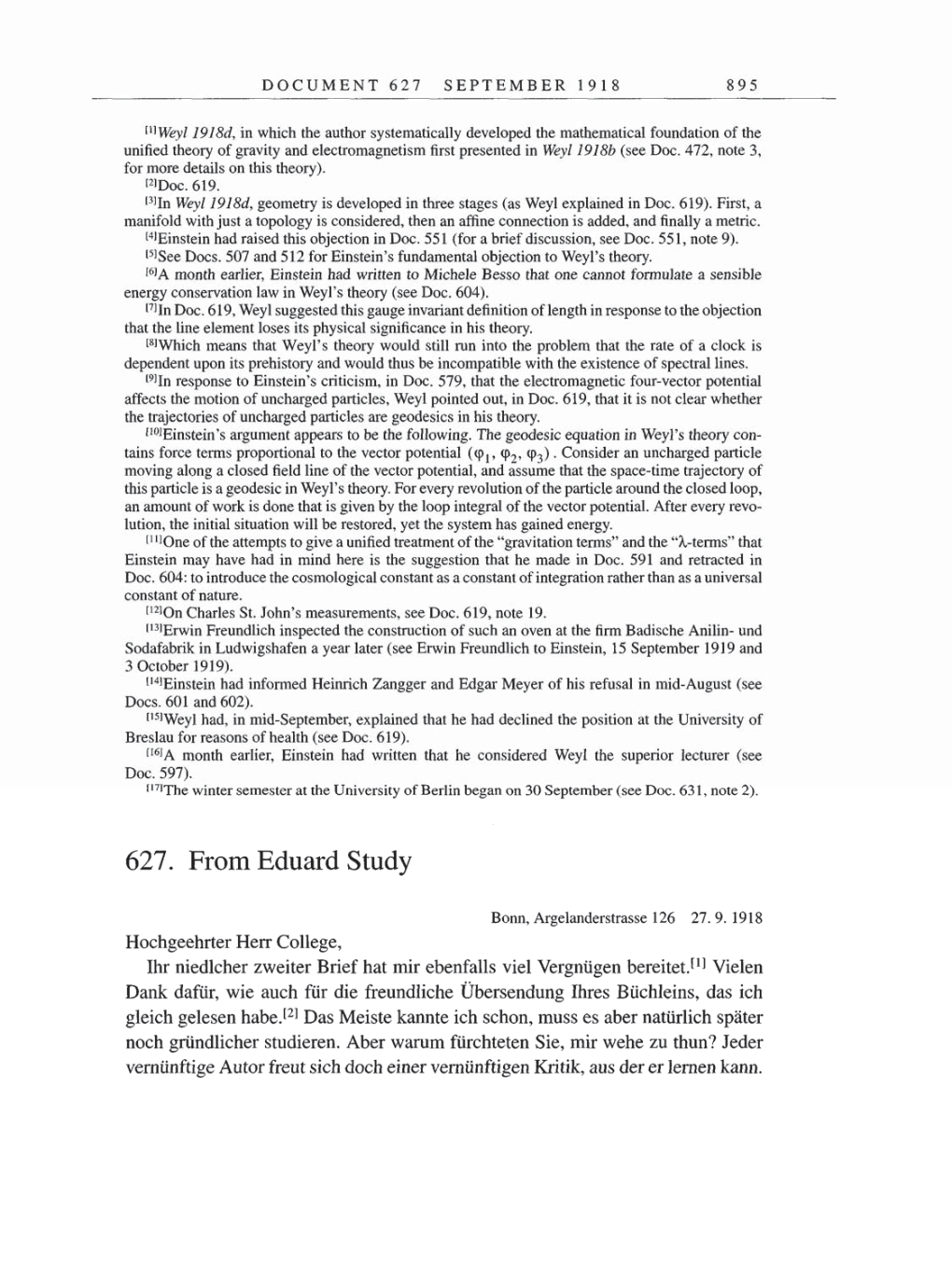DOCUMENT 627 SEPTEMBER 1918 895
[1]Weyl
1918d,
in which the author
systematically
developed
the mathematical foundation
of
the
unified
theory
of
gravity
and
electromagnetism
first
presented
in
Weyl
1918b
(see
Doc.
472,
note
3,
for
more
details
on
this
theory).
[2]Doc.
619.
[3]In
Weyl
1918d,
geometry
is
developed
in three
stages
(as
Weyl explained
in Doc.
619). First,
a
manifold with
just a topology
is
considered,
then
an
affine connection is added, and
finally a
metric.
[4]Einstein had raised this
objection
in Doc. 551
(for
a
brief
discussion,
see
Doc.
551, note 9).
[5]See
Docs. 507 and 512
for
Einstein’s fundamental
objection
to
Weyl’s theory.
[6]A
month
earlier,
Einstein had written
to
Michele Besso
that
one
cannot formulate
a
sensible
energy
conservation law in
Weyl’s theory (see
Doc.
604).
[7]In Doc.
619,
Weyl suggested
this
gauge
invariant definition
of
length
in
response
to the
objection
that the line
element
loses its
physical
significance
in his
theory.
[8]Which
means
that
Weyl’s theory
would still
run
into the
problem
that the
rate
of
a
clock is
dependent upon
its
prehistory
and would thus
be incompatible
with the existence
of
spectral
lines.
[9]In response
to
Einstein’s criticism,
in
Doc. 579,
that
the
electromagnetic
four-vector
potential
affects
the motion
of
uncharged particles, Weyl pointed out,
in Doc.
619,
that
it is
not
clear whether
the
trajectories
of
uncharged
particles
are
geodesics
in his
theory.
[10]Einstein’s
argument appears
to be the
following.
The
geodesic equation
in
Weyl’s theory con-
tains force
terms
proportional
to
the
vector
potential
(Q1, Q2,
Q3).
Consider
an uncharged particle
moving along a
closed field line
of
the
vector
potential,
and
assume
that the
space-time trajectory
of
this
particle
is
a geodesic
in
Weyl’s theory.
For
every
revolution
of
the
particle
around the closed
loop,
an
amount of work is
done
that is
given by
the
loop integral
of the vector
potential.
After
every revo-
lution, the initial situation will be
restored, yet
the
system
has
gained energy.
[11]One of
the
attempts
to
give a
unified treatment of the
"gravitation
terms" and the "A-terms" that
Einstein
may
have had in mind here is the
suggestion
that he made in Doc. 591 and retracted in
Doc. 604:
to
introduce the
cosmological
constant
as a
constant
of
integration
rather
than
as a
universal
constant
of
nature.
[12]On
Charles St. John’s
measurements,
see
Doc.
619, note 19.
[13]Erwin
Freundlich
inspected
the construction
of
such
an oven
at
the firm Badische Anilin- und
Sodafabrik in
Ludwigshafen a
year
later
(see
Erwin
Freundlich
to Einstein, 15
September
1919 and
3
October
1919).
[14]Einstein
had informed Heinrich
Zangger
and
Edgar Meyer
of
his refusal in
mid-August
(see
Docs. 601 and
602).
[15]Weyl
had,
in
mid-September, explained
that he had declined the
position
at
the
University
of
Breslau for
reasons
of
health
(see
Doc.
619).
[16]A
month
earlier,
Einstein had written that he considered
Weyl
the
superior
lecturer
(see
Doc.
597).
[17]The
winter
semester at
the
University
of
Berlin
began on
30
September
(see
Doc.
631, note
2).
627.
From Eduard
Study
Bonn,
Argelanderstrasse
126 27. 9. 1918
Hochgeehrter
Herr
College,
Ihr niedlcher
zweiter Brief
hat
mir
ebenfalls viel
Vergnügen
bereitet.[1] Vielen
Dank
dafür,
wie
auch
für die freundliche
Übersendung
Ihres
Büchleins,
das ich
gleich gelesen
habe.[2]
Das Meiste kannte ich
schon,
muss es
aber natürlich
später
noch
gründlicher
studieren.
Aber
warum
fürchteten
Sie,
mir wehe
zu
thun?
Jeder
vernünftige
Autor
freut sich doch
einer
vernünftigen
Kritik,
aus
der
er
lernen kann.
